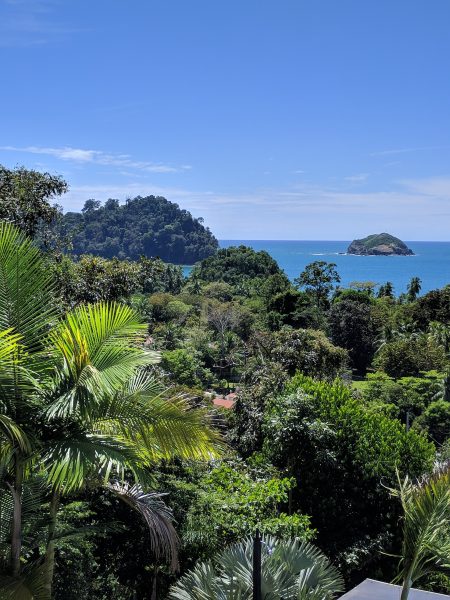February 17, 2018 – Costa Rica has seen its climate change considerably in the last few years. The dry northwestern province of Guanacaste saw rain for the first time during its dry season. The locals could not remember the last time a week of rainy weather happened in the month of January. And then there are the winds. Normally Guanacaste sees the wind in January and February. But nothing like the winds witnessed this year. These are gusts so strong they drive visitors from normally quiet beaches because of sudden blasts of airborne sand.
As we drove to the airport in Liberia before departing, the winds were providing the evidence of change in the skies in front of us. Loose, dry soil blew across the highway. Palm trees bent over. And debris from sugar cane fields scattered on the roadways. In the three years we have been visiting the country we had seen nothing like this. And our guide and driver agreed. In his late 30s, he couldn’t recall conditions like this in his memory. And nor could other Ticos (what Costa Ricans call themselves) to whom we spoke. When we return to Costa Rica in 2019 we may see even more evidence of climate change, no longer creeping along, but rather accelerating in unforeseen ways.
Why is this happening?
According to the latest satellite observations change is accelerating. We may blow through the IPCC Paris target of containing the rise to less than 2 Celsius (3.6 Fahrenheit) far sooner than what our climate models of the last decade predicted. In fact, the odds are global mean temperatures will increase by as much as 4 to 6 Celsius (7.2 to 10.8 Fahrenheit) by 2100. Revised climate models fed by new real-time data are predicting our world will be 15% hotter than any previous estimates.
Researchers into climate change are refining existing models, narrowing the range of uncertainty to a point where today their predictions are a better reflection of the real world of climate. But even so, it appears that change is accelerating creating real-world extreme weather that the best models cannot predict. Just look at the rate of Arctic Ocean sea ice melt versus models and you can note the difference. The reality is outpacing the simulation. As one climate scientists recently stated, it’s no longer about predicting the future, it’s about explaining the extreme present.
So what happens if we see mean temperature rises of 4 to 6 Celsius?
Back in January, I wrote about what the difference between 1.5 and 2 Celsius would mean to global climate. It was huge with projections indicating an increase in planetwide aridity of 25% over the next half-century.
But a 4 Celsius rise would be far worse. In a recent World Bank report it describes the consequences:
- inundation of most of Earth’s coastal cities;
- higher global malnutrition from declines in food production;
- dryer regions getting dryer;
- wetter regions getting wetter;
- unprecedented heat waves in tropical areas;
- freshwater scarcity in many areas of the planet;
- increased frequency of high-intensity storms, tropical cyclones, and hurricanes;
- an irreversible loss of biodiversity on land;
- extensive coral reef systems loss in the world’s oceans.
In the World Bank report, it notes that a 4 Celsius rise would be a return to a period that followed the end of the last Ice Age. It states that unless the nations of the world seriously cut their carbon burning habits that we could see a 4 Celsius rise as early as the 2060s. It goes on to say that left unchecked the warming could increase a further 2 Celsius by the end of the century.
For the poorest regions of the Earth, this will be an unrecoverable condition. And where are these poorest regions? Largely in the tropics where extreme heat, wind, and other weather will become more the norm. Coping will be far more difficult under these extremes.
In the polar regions, absolute warming will be much higher than 4, 5 or 6 Celsius. Today with the world almost 1 Celsius degree warmer than it was in the pre-Industrial era of the mid-19th century, Arctic temperatures have risen between 3 and 5 times the global mean. So we likely can expect temperatures in places like northern Canada, the Scandinavian countries, Alaska, and Siberia, to rise by 10 Celsius or more.
And with warming will come sea level rise. It will vary regionally based on the shape of land masses, and the presence of coastal ocean currents. But it will be substantial particularly in tropical zones. In fact, the variability will be as much as 20% between the tropics and temperate ocean latitudes. The rise will be between 0.5 and 1 meter at 4 Celsius, and more if the thermometer gets closer to 6. That’s above the projections of a 1 to 2-meter rise expected by 2100 in the face of global warming of only 1.5 Celsius.
For my wife and I, these dire predictions have us traveling to Costa Rica annually while we can still appreciate what we have. I hope that world leaders end their temerity in addressing the carbon issue, educate the public to the threat we collectively face, and double down on moving away from burning fossil fuels to support our modern world. We have the means and technologies to end our carbon addiction. We need the will to do it.
















